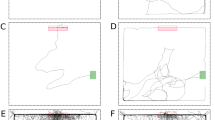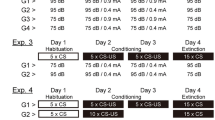Abstract
In crickets Gryllus bimaculatus, flight has been shown to be able to promote aggressive encounters between males and to suppress escape behavior. The aim of this study was to examine the influence of flight on male behavior in male–female interactions. We found that flown males demonstrate enhanced courtship behavior. The latency of calling song was significantly shorter, while the relative total duration of singing as well as the duration of singing episodes longer in flown males than in the control. Mating rate was also significantly higher in the experimental group containing flown males. The results suggest that, in addition to previously reported effects on aggressiveness and escape, flying has a profound accelerating effect on male courtship behavior.




Similar content being viewed by others
References
Adamo SA, Hoy RR (1994) Mating behavior of the field crickets, Gryllus bimaculatus, and its dependence on social and environmental cues. Anim Behav 47:857–868
Adamo SA, Hoy RR (1995) Agonistic behaviour in male and female field crickets, Gryllus bimaculatus, and how behavioural context influences its expression. Anim Behav 49:1491–1501
Adamo SA, Linn CE, Hoy RR (1995) The role of neurohormonal octopamine during “fight or flight” behaviour in the field cricket Gryllus bimaculatus. J Exp Biol 198:1691–1700
Alexander RD (1961) Aggressiveness, territoriality, and sexual behaviour in field crickets (Orthoptera: Gryllidae). Behaviour 17:130–223
Boake CRB (1983) Mating systems and signals in crickets. In: Gwynne DT, Morris K (eds) Orthopterian mating systems: sexual competition in a diverse group of insects. Westview, Boulder CO, pp 28–44
Bennet-Clark HC (1989) Songs and the physics of sound production. In: Huber F, Moore TE, Loher W (eds) Cricket behavior and neurobiology. Cornell University Press, Ithaca NY, pp 227–261
Dyakonova VE, Sakharov DA, Schürmann F-W (1999) Effects of serotonergic and opioidergic drugs on escape behaviors and social status of male crickets. Naturwissenschaften 86:435–439
Dyakonova VE, Schürmann F-W, Sakharov DA (2000) Social aggressiveness of female and subordinate male crickets is released by opiate receptor antagonist. Acta Biol Hung 51:363–367
Dyakonova VE, Schürmann F-W, Sakharov DA (2002) Effects of opiate ligands on intraspecific aggression in crickets. Peptides 23:835–842
Gray DA, Cade WH (1999) Sex, death, and genetic variation: natural and sexual selection on cricket song. Proc R Soc Lond B 266:707–709
Hofmann H (1997) Aggression bei Grillen: Funktion und Mechanismen—Verhalten und Pharmakologie. Dissertation, Universitaet Leipzig
Hofmann HA, Schildberger K (2001) Assessment of strength and willingness to fight during aggressive encounters in crickets. Anim Behav 62:337–348
Hofmann HA, Stevenson PA (2000) Flight restores fight in crickets. Nature 403:613
Kortet R, Hedrick A (2005) The scent of dominance: female field crickets use odour to predict the outcome of male competition. Behav Ecol Sociobiol 59:77–83
Loher W (1989) Temporal organization of reproductive behavior. In: Huber F, Moore TE, Loher W (eds) Cricket behavior and neurobiology. Cornell University Press, Ithaca NY, pp 83–113
Matsumoto Y, Sakai M (2001) Brain control of mating behavior in the male cricket Gryllus bimaculatus DeGeer: excitatory control of copulatory actions. Zoological Science 18:659–669
Nagamoto J, Aonuma H, Hisada M (2005) Discrimination of conspecific individuals via cuticular pheromones by males of the cricket Gryllus bimaculatus. Zoological Science 22:1079–1088
Rantala MJ, Kortet R (2003) Courtship song and immune function in the field cricket Gryllus bimaculatus? Biol J Linn Soc 79:503–510
Rantala MJ, Kortet R (2004) Male dominance and immunocompetence in a field cricket. Behavioral Ecology 15:187–191
Sakai M, Matsumoto Y, Takemori N, Taoda Y (1995) Postcopulatory sexual refractoriness is maintained under the control of the terminal abdominal ganglion in the male cricket Gryllus bimaculatus De Geer. J Insect Physiol 41:1055–1070
Savage K, Hunta J, Jennions M, Brooksa R (2005) Male attractiveness covaries with fighting ability but not with prior fight outcome in house crickets. Behav Ecol 16:196–200
Shiga S, Kogawauchi S, Yasuyama K, Yamaguchi T (1991) Flight behaviour and selective degeneration of flight muscles in the adult cricket (Gryllus bimaculatus). J Exp Biol 155:661–667
Simmons LW (1986) Inter-male competition and mating success in the field cricket, Gryllus bimaculatus (De Geer). Anim Behav 34:567–579
Simmons LW (1988a) Male size, mating potential and lifetime reproductive success in the field cricket, Gryllus bimaculatus (De Geer). Anim Behav 36:372–379
Simmons LW (1988b) The calling song of the field cricket, Gryllus bimaculatus (De Geer): constraints on transmission and its role in intermale competition and female choice. Anim Behav 36:380–394
Stevenson PA, Hofmann H, Schoch K, Schildberger K (2000) The fight and flight responses of crickets depleted of biogenic amines. J Neurobiol 43:107–120
Stevenson PA, Dyakonova VE, Rillich J, Schildberger K (2005) Octopamine and experience-dependent modulation of aggression in crickets. J Neurosci 25(6):1431–1441
Tregenza T, Wedell N (1997) Definite evidence for cuticular pheromones in a cricket. Anim Behav 54:979–984
Tregenza T, Wedell N (2002) Polyandrous females avoid costs of inbreeding. Nature 415:254–256
Walker TJ (1986) Monitoring the flights of field crickets (Gryllus spp.) and a tachinid fly (Euphasiopteryx ochracea) in north Florida. Fla Enthomol 69:678–685
Zahavi A (1975) Mate selection—a selection for a handicap. J Theor Biol 53:620–625
Zheverikhin VV (2002) Ecological history of terrestrial insects. In: Rasnitsyn AP, Quicke DLJ (eds) History of insect. Kluwer, Dordrecht, pp 331–387
Acknowledgements
We thank Prof. D. Sakharov and two reviewers for comments on earlier version of this manuscript. This work was supported by grant 05-04-49812 and 08-04-00120 from RFBR and “Science support foundation”. We declare that the experiments comply with the current laws of Russian Federation.
Author information
Authors and Affiliations
Corresponding author
Rights and permissions
About this article
Cite this article
Dyakonova, V., Krushinsky, A. Previous Motor Experience Enhances Courtship Behavior in Male Cricket Gryllus bimaculatus . J Insect Behav 21, 172–180 (2008). https://doi.org/10.1007/s10905-008-9117-4
Revised:
Accepted:
Published:
Issue Date:
DOI: https://doi.org/10.1007/s10905-008-9117-4




